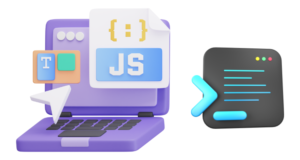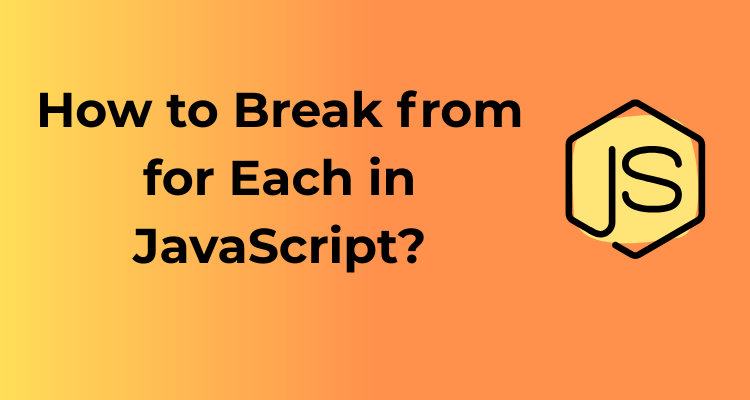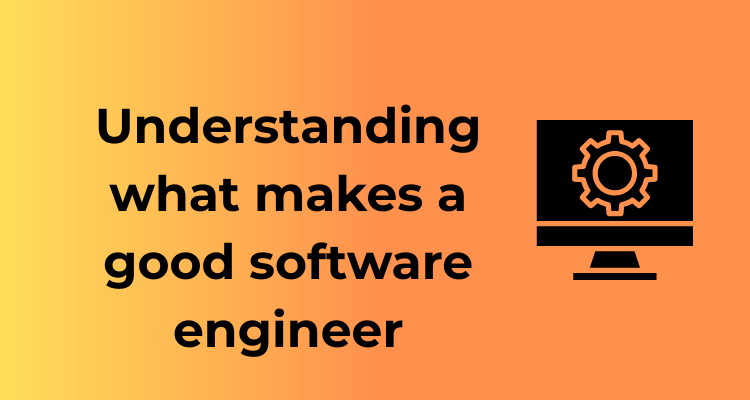Alright, fellow coder, let’s get straight to it. You’re knee-deep in JavaScript, happily iterating over an array with forEach, when suddenly, you realize you need to stop the loop early. Maybe you’ve found what you’re looking for, or maybe there’s just no reason to process the rest of the items. So, you reach for trusty old break… only to find it doesn’t work. Why?
The frustration is real, but there’s a reason for this madness! The forEach loop behaves differently from traditional loops like for or while. It’s part of the array methods in JavaScript, and here’s the kicker: it’s designed to process every single item in the array.
What Makes the forEach Function Stubborn?
The reason you can’t directly break out of a forEach loop is that it’s not just a regular loop under the hood; it’s a higher-order function. This means it’s meant to execute a callback function for each element in the array without any intention of stopping halfway.
Think of it as a machine that’s built to do one job – run that callback on every single item. It doesn’t listen to commands like break or continue because, in the context of forEach, those are not part of how it operates. The control flow of break simply doesn’t make sense in this setup because the loop isn’t “traditional” and isn’t controlled in the same way as a for loop.
Wait, Isn’t This a Bit Limiting?
It might seem like a limitation, but the creators of JavaScript had good reasons for this. forEach is all about abstraction. It handles the looping mechanics for you and makes your code concise and readable. It’s purposefully designed to simplify iteration when you know you’ll process everything in an array. Different tools for different needs, right?
In many scenarios where you’d use forEach, breaking out of the loop isn’t something you’d normally want to do. That’s likely why the language architects didn’t prioritize adding support for this type of control flow. However, I know what you’re thinking: “But what if I really, really need to exit a forEach loop?”

The Actual Loop Mechanics Behind JavaScript’s forEach
Let’s dive into how forEach really works under the hood. Spoiler alert—it’s not magic! Understanding its actual mechanics will give you better insight into why it behaves the way it does and why it works differently from some of the other loops in JavaScript. Ready? Let’s go!
How Does forEach Operate?
The forEach method in JavaScript is designed to iterate over elements in an array. Think of it like a courier delivering packages. It takes your array, processes each element one by one, and executes a callback function on each of them.
The callback function you pass into forEach is where the magic happens. This function is called for every array element. It receives three arguments:
- The current element being processed.
- The index of that element in the array.
- The entire array, in case you need it for any reason.
For example:
const array = [10, 20, 30];
array.forEach((item, index, arr) => {
console.log(`Element: ${item}, Index: ${index}`);
});
Here, forEach loops through each number in the array, running the provided callback function. It’s simple, effective, and expressive!
One Key Thing – Iteration Happens Automatically
One core mechanic of forEach is that you, as the developer, don’t control the flow of the iteration directly. Unlike for and while loops where you explicitly move from one iteration to the next, in forEach, the iteration is handled automatically for all elements in the array.
This hands-off approach is part of what makes forEach user-friendly in simple cases. But as we’ll see, it also introduces limitations when you want to exert more control over how the iteration should behave.
Where It Gets Interesting – Behavior with Empty Indexes
Something you might not know: forEach skips over empty slots in sparse arrays. For instance:
const sparseArray = [1, , 3]; // Notice the empty slot!
sparseArray.forEach(item => {
console.log(item); // Logs 1 and 3; skips the empty slot.
});
This behavior aligns with how other array processing methods like map and filter treat sparse arrays. It’s a subtle but important aspect of forEach.
Why Doesn’t It Return a Value?
Another defining mechanic of forEach is that it doesn’t return anything. Its sole purpose is side effects—executing some logic for each array element. Need to produce and return a transformed array? That’s what the map method is for!
Common Misconceptions Around Breaking forEach Loops
When it comes to forEach loops in JavaScript, there’s no shortage of misunderstandings about how they work. Let’s clear up some of the common misconceptions out there so you can approach your code with confidence!
“Can’t I just use break in a forEach loop?”
This is probably the first confusion you’ll come across when using forEach. It’s tempting to think that you can break out of the loop using the trusty break keyword—after all, it works in a for or while loop, doesn’t it? But here’s the deal: forEach is a higher-order function, not a traditional loop. That means break simply doesn’t apply here, and trying to use it will result in a syntax error. Bummer, right?
It’s worth understanding that forEach is more like a method that iterates over elements in an array, and it doesn’t have the built-in mechanisms for controlling flow, such as break or continue. This misconception often leads developers to frustration if they dive straight into coding without fully grasping how forEach works.
“But can’t I use return to stop a forEach early?”
Well, not really—not in the way you might hope. Some developers assume that using return inside the callback function will halt the iteration entirely. While it’s true that return will stop the current callback’s execution for that specific iteration, it won’t escape the larger forEach loop. The loop will continue to the next element regardless of what happens within one iteration. This misconception usually comes from confusion between return and break and their respective roles in JavaScript logic.
“Is forEach bad because I can’t break it?”
Not at all! Although the inability to break directly from a forEach loop can feel limiting at first, it’s not a design flaw. In fact, forEach was designed with a specific purpose in mind: to create a clean, declarative, and functional way of iterating through arrays.
- If you need more control over loop flow, JavaScript offers other tools, like
for,for...of, orwhile, which allowbreakorcontinue. forEachis ideal when your focus is on applying a function to every element in an array—but not when you need conditional breaks.
To sum it up, forEach isn’t inherently flawed—it’s just not designed to handle early exits! Use it when you’re confident that every array element should be processed, and avoid it when you need fine-grained control over the loop’s flow.
Clever Alternatives: Using for Loops Instead
Let’s talk about a lifesaver when forEach just doesn’t cut it: the good ol’ “for” loop. Who knew something as basic as a “for” loop could step in as the hero when you need to break out of your looping code drama? Trust me; it’s not just a fallback—it’s a highly versatile and reliable option.
Why Consider for Loops as an Alternative?
Unlike forEach, which guarantees execution for every single element in your array, a for loop gives you total control over the flow of your program. If you need to stop iterating at a specific condition, you can simply use a break statement. No hoops to jump through, no headaches!
Here’s an example to clarify:
const fruits = ['apple', 'banana', 'orange', 'mango'];
for (let i = 0; i < fruits.length; i++) {
if (fruits[i] === 'orange') {
console.log('Found an orange! Let’s stop the loop.');
break; // Exit the loop immediately
}
console.log(fruits[i]); // Outputs: 'apple', 'banana'
}
See how easy that was? The break statement gives you freedom. Once you’ve found an “orange” in the list above, you’re out of the loop—no need to keep checking the rest of the fruits.
A Quick Refresher on For Loops
Before we dive into more reasons why for loops can be a clever workaround, let’s quickly review their structure:
- Initialization: Start a counter variable (e.g.,
let i = 0). - Condition: Define when the loop should stop (e.g.,
i < array.length). - Increment/Decrement: Update the counter after each iteration (e.g.,
i++).
This structure is simple yet flexible, giving you total command over every step of your loop. It’s like having a remote control for your iterations!
When to Choose For Loops Over forEach
You might be wondering, “When would I ever pick a for loop over a forEach loop?” Great question. Here are some scenarios when a for loop outshines its counterpart:
- When you need to break or exit early: As we’ve discussed,
forEachcommits to processing every element, but aforloop gives you total flexibility to stop whenever you feel ready. - When performance is a priority: While not always noticeable,
forloops can be slightly faster thanforEachbecause they avoid callback overhead. - When you need more control: Whether it’s skipping iterations (using
continue) or dynamically altering the loop behavior,forloops put you in the driver’s seat.
What About Readability?
A common counterpoint is that forEach often leads to cleaner, more readable code. And yes, it’s true that for simple one-off tasks, forEach can reduce boilerplate. However, when your needs get more complex—like breaking out of a loop, handling nested iterations, or dynamically manipulating the flow—a for loop can be just as easy to read and much more effective.
Breaking Patterns with forEach: Using try-catch or Errors
Alright, let’s dive into some crafty solutions for tackling the notorious “can’t break out of a forEach loop” problem! Spoiler alert: You can’t break out of forEach directly, but there is actually an unconventional (and slightly rebellious) way to force your way out – using try-catch or throwing errors.
Wait, What? Using Errors to Exit a Loop?
Yes, you heard that right! The idea here is to leverage how JavaScript handles exceptions. When you throw an error within the forEach callback, it immediately halts execution of the loop because an exception has occurred. Combine that with a try-catch block, and bam – you’ve got a pseudo way to “break” from your forEach.
This isn’t the textbook approach to avoid iterating through every single element (because forEach isn’t designed to support breaks). But for those moments when other looping methods aren’t feasible, this is a trick you can keep in your developer toolkit.
Let’s Look at an Example
Here’s how the try-catch block and throw method can work together to control a forEach loop:
try {
const numbers = [1, 2, 3, 4, 5];
numbers.forEach(num => {
console.log(num);
if (num === 3) {
throw new Error("Breaking the loop!");
}
});
} catch (err) {
console.log("Loop stopped: ", err.message);
}
Output:
- 1
- 2
- 3
- Loop stopped: Breaking the loop!
As soon as the number “3” is encountered, we throw an error, which halts the forEach from further execution. The error is caught in the catch block, allowing us to gracefully handle this break-like behavior.
The Upsides (and Trade-Offs)
Let’s address the pros and cons of this quirky approach:
Pros:
- Force a premature exit: It’s a neat workaround in situations where you have no control over the use of
forEach. - Readable conditional logic: The point at which you want to stop the loop is inherently clear in the
throwstatement.
Cons:
- Not clean or recommended: Using exceptions for flow control violates coding best practices; it’s more of a hack than a go-to solution.
- Potential for misuse: Overusing this pattern can make your code harder to debug and maintain.
When to Use This Technique
This trick isn’t meant to replace cleaner alternatives like for loops or for...of, which offer native support for breaking. However, if you’re working within constraints (like an external library that mandates forEach), this can come in handy as a last resort.
Combining Callbacks and External State to Simulate Break
So, you’re working your way through a forEach loop in JavaScript, and suddenly you realize: “Wait a minute! I really need to break out of this loop early, but forEach just won’t let me do it!” Don’t worry—you’re not out of options just yet. While forEach doesn’t support a break statement like a traditional for loop does, there are clever ways to simulate this behavior using callbacks and an external state.
What Does “External State” Mean?
Think of external state as a variable or flag that exists outside the loop scope but plays an active role within it. Essentially, you can set up some criteria, and when that condition is met, you “simulate” breaking out of the loop by halting further execution of the callback function.
This may not be as straightforward as a regular break, but it’s a powerful way to control how and when your loop logic executes without completely changing how you use forEach.
How It Works: A Practical Example
Let’s break it down with an example. Imagine you’re processing an array of numbers, and you want to stop iterating as soon as you find a number greater than 10. Here’s how you could approach this:
const numbers = [1, 5, 8, 12, 18];
let stopLoop = false; // External state
numbers.forEach((num) => {
if (stopLoop) return; // Simulating "break"
console.log(num);
if (num > 10) {
stopLoop = true; // Update external state
}
});
What’s happening here? The external stopLoop variable essentially acts as the ruler of your loop. Once it’s set to true, the loop doesn’t execute the body of the callback function anymore. While the forEach itself still iterates over the full array internally, you successfully circumvent additional processing through this external flag.

Advantages of This Technique
Why go through the trouble of combining callbacks and external state? Here’s why this approach can be surprisingly helpful:
- Simplifies logic: You don’t need to restructure your entire code with other loop constructs like
fororwhile. - Readability: Using an appropriately named external variable, like
stopLoop, makes it clear to others (or future you) that you’re simulating a break condition. - Non-invasive: If you’re working in a project where switching to
forloops might require refactoring other code, this lets you achieve break-like behavior without rewriting everything.
Limitations to Be Aware Of
Despite its benefits, this method does come with some limitations and trade-offs:
- Performance impact: The forEach loop continues iterating over all elements even though further processing halts. For smaller datasets, this isn’t a big deal, but for massive arrays, consider alternatives like
fororsome. - Debugging complexity: If you over-complicate the usage of external variables, it can make debugging a bit trickier.
Practical Use Cases and Best Practices for Loop Efficiency
Alright, let’s talk about making your loops more practical and efficient. The forEach method is a nifty JavaScript tool that’s pretty versatile. But when it comes to loop performance and best practices, there are a few things to keep in mind. Whether you’re processing large data sets or designing real-time applications, getting the most out of your loops is crucial. So, let’s dig into practical use cases and proven tips for optimizing efficiency.
1. Practical Use Cases Where forEach Shines
The forEach method works wonders in scenarios where you need to perform side effects on every item in an array. For example:
- Rendering UI Components: Iterate over an array of data (like product lists or chat messages) and render DOM elements for each item.
- Logging or Debugging: Cycle through an array to log values for troubleshooting or debugging purposes without altering the data.
- Light Data Transformations: Use it for simple operations like adding new properties to objects or updating values in an array when mutation isn’t a concern.
These scenarios benefit from forEach because it’s clean, concise, and keeps the code readable. However, it’s critical to be mindful of how and when you use it—it’s not the best for everything!
2. Understand When to Choose Other Loops for Efficiency
It’s important to know that forEach isn’t always the fastest option. Sure, it looks cleaner, but there are cases where alternatives like for, for...of, or even map make more sense.
For example:
- When Performance Matters: If you need to work with arrays that have thousands or millions of elements, vanilla
forloops tend to be faster because they don’t require callback functions. - When You Need to Break or Return Early: Since
forEachdoesn’t let youbreak, using aforloop lets you exit as soon as your condition is met, optimizing performance. - Data Transformations: If your goal is to transform data into a new array,
mapis often a better fit, as it’s specifically designed for that purpose and fits functional programming paradigms.
3. Best Practices to Maintain Loop Efficiency
Keeping your loops efficient ensures scalability and snappier applications. Here are a few friendly tips to stay on track:
- Avoid Nested Loops: If you find yourself nesting
forEachinside anotherforEach, try to refactor. Nested loops can grow exponentially in time complexity, slowing things down. - Leverage Built-in Methods: Don’t reinvent the wheel. When sorting, filtering, or mapping data, use array methods like
filter,sort, andmapthat are optimized for these tasks. - Use Throttling or Debouncing: If your loop is tied to events (like scrolls or inputs), pair it with throttling or debouncing techniques to improve performance and avoid unnecessary operations.
- Limit Overall Data Sets: Instead of running
forEachon a massive array, consider breaking your data into smaller chunks to process in manageable bits. This also helps with memory management. - Keep Callback Functions Clean: Avoid bloating your callback logic. If it’s doing too much, break it into smaller, reusable functions.
4. Real-Life Scenario: Pagination for Large Data Sets
A common scenario in real-world apps is handling large data sets, such as displaying search results or a user database. Instead of iterating over the whole array with forEach, implement pagination. Process only a slice of the array based on the current page the user is viewing. Not only does this approach save resources, but it’s also user-friendly since data loads faster.









